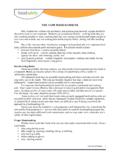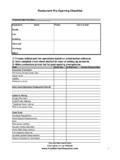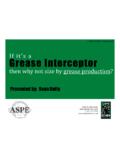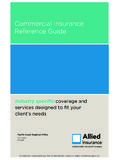Transcription of Golf Facility Checklist Guide - The ISC-Audubon …
1 golf Facility Checklist Guide Description of Operations golf courses are outdoor recreational areas where the sport of golf is played. A. round of golf consists of playing 18 holes and golf courses, as such, are typically designed with 18 holes. Smaller facilities, commonly called executive courses, may consist of 9 holes that are played twice to complete 18 holes. Large facilities may have multiple courses. golf courses may be public, private, or semi-private, and may be stand-alone operations or affiliated with hotels, residential communities, country clubs, or other entities. This report will address the golf course and closely-related operations. It will not address hotels, residential communities, or other non-related operations. Facility . The typical golf course Facility will include the course itself, a club house, golf cart barns, and course maintenance facilities. There may also be ancillary structures throughout the course, such as weather shelters or snack bars.
2 Courses may have driving ranges, putting greens, or other practice facilities. There will also be parking areas for players and staff. An 18-hole golf course can range in size from less than 60 acres to over 100 acres. The course will consist of both playing area and scenic space separating the individual holes. The playing area of each hole consists of the tee ground, the putting green area, and the space connecting these two areas. The course may be designed to take advantage of the natural features of the terrain or the course may be artificially landscaped. In general, courses may be classified as links or woods courses depending upon the openness of the course. Courses will have both natural and man-made hazards, such as steep slopes and drop offs, rough terrain, sand traps, streams, and ponds. Most courses will have underground irrigation systems with integral standpipes and hose bibs or sprinklers to facilitate course watering.
3 If golf carts are permitted on the course, there will be designated paths, which may be paved. Depending upon the availability of land, courses may cross public or private roads. Courses are natural settings and may be inhabited by a variety of wildlife. Some courses may be lighted to allow for nighttime play. Clubhouses facilities may include a pro shop, where golf equipment and apparel is sold; restrooms; locker rooms and shower facilities; office areas; and food and beverage services, which may range from snack counters to full-service restaurants and bars. Courses that rent golf carts will have storage, fueling/charging areas, and maintenance facilities for the vehicles. These facilities are typically covered to protect the carts from the weather. Fueling/charging equipment will vary depending upon whether the cart is powered by electricity, gaseous fuels, or liquid fuels. Maintenance facilities will include both wash areas, where the carts may be cleaned, and mechanical repair areas.
4 In resort areas, courses may rent space for regular customers to store their own golf carts on the premises. Outdoor power equipment used to maintain the course and Facility will have a dedicated storage, fueling, and maintenance area. There will also be storage, mixing, and equipment loading areas for fertilizers, pesticides, and other chemicals applied to the course. Courses that are not designed for golfers to return to the clubhouse area after nine holes may have on-course bathrooms, snack bars, or weather shelters. If the course hosts tournaments, there may be permanent grandstands or bleachers around designated holes; these structures may also be constructed on a temporary practice facilities may include full length driving ranges, swing cages ( , mats and enclosed netting), practice greens, and practice hazards. These facilities may be used by golf course professionals to give lessons on a fee basis. People.
5 A variety of people work for golf course facilities. These range from golf course managers, golf teaching professionals, course superintendents, course maintenance personnel, course security, golf shop sales people, and bar or restaurant personnel. The golf course manager is responsible for the direction and supervision of all course activities and the personnel assigned to those activities. The course superintendent is responsible for maintenance of the course and adjacent landscaped areas, including buildings and structures. Maintenance workers may operate mowing equipment; water tees, greens, and fairways; spray chemicals; prune trees and shrubbery; repair and replace pipe on irrigation systems; maintain ball washers; and perform other maintenance activities. Most maintenance employees will spend large amounts of time working outdoors. Pro shops, food services, and other concessions may be contracted out to third parties.
6 Services . The primary services provided by golf courses is to provide golfers with access to the golf course and patrol the course to expedite play and enforce applicable course rules and regulations. The course may sponsor golf leagues or tournaments. Course professionals may also provide instruction to interested persons on an individualized or group basis. Starting times may be arranged through the course starter. Most courses will allow golfers to reserve a starting time in advance of the day of play. At the designated starting time, the golfer will report to the starter, pay their fee, and be allowed on the course. The golfer will also arrange a golf cart or equipment, if needed. At the end of the round, golfers that have rented items will return them. They may shower and change in the club house, and dine or drink. Equipment . Equipment found at golf courses includes golf carts, outdoor power equipment ( , lawn mowers, cultivators, and grading equipment), fertilizer and pesticide application equipment; hoses, sprinklers, and irrigation systems; golf carts; off-road utility vehicles; fuel tanks and dispensing equipment; power washers; air compressors; and other tools and maintenance equipment.
7 There will also be kitchen and restaurant equipment, cash registers, computers, office equipment, counters, tables, chairs, and other related equipment. Facilities that have tournaments may have portable scoreboards, bleachers, grandstands, lighting, or sound systems. Materials . The primary consumable materials at golf courses will be pro shop stock ( , golf clubs, balls, bags, and apparel), food, cleaning supplies, golf course chemicals, fuels, course tickets, and paper goods. Additional Information - In addition to the references provided at the end of the report, the following are a list of useful information sources concerning golf course operators: golf Course Superintendents Association of America, National golf Course Owners Association, National golf Foundation, golf Association, What is this Checklist For? This Checklist was developed to help you assess the current conditions at your Facility and, when applicable, improve the way your Facility operates.
8 This Checklist is to be used as a Guide . It does not include all applicable legal requirements. Business owners are responsible for obtaining complete information about applicable regulations. The Checklist includes questions concerning best management practices (BMPs) that make good business sense and also protect the environment. You may choose to implement some of these BMPs if you are not already using them in day-to-day operations. As this Checklist is only a Guide , some of the questions may not be applicable to your Facility . Wash Area Yes No N/A. 1. Is there proper curbing and sloping of the wash pad to prevent runoff? 2. Is all the wash water and rinse water directed into the recycle system? 3. Is the Facility graded to prevent wash water, rinse water or stormwater from ponding on site? 4. Is there sufficient overhang to prevent or minimize the entry of stormwater or rainwater into the recycle system? 5. Is the Facility free from odors?
9 6. Is the area free from leaks or other signs of water discharging to the ground? 7. Is all overspray trapped in the wash area? 8. Is the vehicle placed well within the wash area and away from the edges of the wash pad to prevent wash water runoff to the ground? 9. Are all vehicle repairs done away from the wash area to prevent the transport of chemicals in the wash water runoff? 10. Are all chemicals and other materials stored away from the wash area preventing the transport of chemicals in the wash water runoff? 11. Is all pre-washing, washing, or rinsing done inside the wash pad? 12. Are signs posted to discourage the dumping of vehicle fluids (oil, coolant), pesticides, solvents, fertilizers, organic chemicals, toxic chemicals into the drain or the collection sump? 13. Is there a Do not use engine degreasing solvents in the wash area sign posted near the drain or collection sump? 14. Is the area kept clean, orderly and safe?
10 Oil Yes No N/A. 1. Are absorbent pads available for use when oily sheen appears? 2. Is used oil stored properly on an impervious floor? 3. Are drip pans used to collect used oil? 4. Are the used oil storage containers covered and properly labeled USED OIL ? 5. Is there adequate spill containment in the oil storage location? 6. Is the used oil handler registered with DEP? 7. Is documentation of proper used oil and oily waste management kept on-site ( receipts, invoices)? Wastewater Yes No N/A. 1. Is wastewater prevented from discharging into surface or ground waters? 2. Is the wastewater disposed of according to local rules and regulations? 3. Are there adequate records to document the disposal of wastewater according to local rules and regulations? 4. Is the proper authorities notified if an unanticipated bypass, upset in the system or unauthorized discharge has occurred? 5. Is a remedial plan put in place when unauthorized discharges occur?





